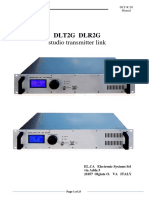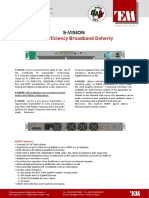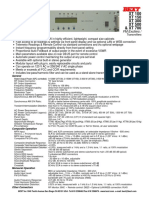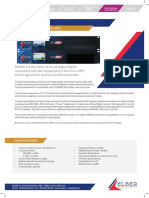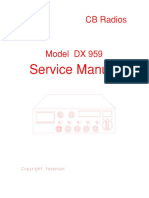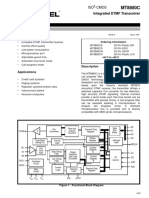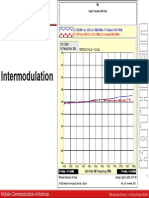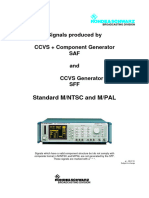VIMESA FM MANUAL SERVICIO 3KW LCD 2
Uploaded by
José LópezVIMESA FM MANUAL SERVICIO 3KW LCD 2
Uploaded by
José LópezUSER MANUAL
2 - 3KW BLUE PLUS LCD SERIES
Document structure
This document contains all the technical information relating to the transmitters of Series BLUE
PLUS LCD.
In the first part we have all the technical specifications, followed by information for the first
installation of the transmitter.
In the middle there is the explanation of the menu and functions of the transmitter, such as color
display touch screen.
Finally, follow the wiring diagrams and layouts.
Scope of the document
Purpose of this document is to provide a comprehensive description of the functionalities of the BLUE PLUS LCD
TRANSMITTER and to provide operating information on the software elements of the system.
BLUE PLUS LCD TRANSMITTER User Manual provides software setup information.
Introduction
The transmitter BLUE PLUS LCD is designed with all the latest technologies, such as high efficiency using
the latest generation LDMOS transistor and Power Supply. We used a modern interface and performance
using a color display with touch screen, with easy management software and easy to use. Each transmitter
BLUE PLUS LCD is equipped with a LAN interface with the possibility of remote control completely
transmitter operation.
The transmitter BLUE PLUS LCD is equipped with all audio inputs including Audio IP, for a complete audio
interface.
Features
State of the art performance
LCD color display with touch screen for easy setting and reading parameters
Extremely low distortion: THD, IMD & TIM (Transient Intermodulation Distortion) specified
Highest stereo performance: typ. 60 dB
L,/R, RDS / SCA, AUX, MPX, AES-EBU XLR & Optical, Audio IP
Six Memory (frequency, sensitivity, power, etc. ) which can be stored different setting.
Ready for N+1 system
Completely broadband
Remote control for telemetry LAN, RS485
RF amplifiers using the latest generation of semiconductors RF Power LDMOS
Automatic Power Control (APC) maintaining stable pre-set RF power 1.5:1 VSWR. Higher
VSWR value causes power reduction
Nominal RF output level 3000W. Continuously adjustable power output
Built-in RF harmonics filter and true wattmeter
High spectral purity
CCIR & FCC compilant
Technical Specifications
GENERAL MULTIPLEX OPERATION
Power Output: 3000W, adjustable from front panel. Composite Input Impedance: 2 Kohm unbalanced.
RF Output Impedance: 50 ohm. Composite Input Level: Digital -12 to +12 dBm, Analog -6 to +18 dBm
RF Output Connector: “7/8”. Input Connector: BNC female.
Monitor RF: BNC connector. Composite Amplitude Response: ±0.1 dB, 30 Hz to 100 KHz.
VSWR: 1,5:1 Total Harmonic Distortion + Noise: 0.01% @ 400 Hz.
Frequency Range: 87.5 ÷ 108.00 MHz, only for analog on request Intermodulation Distortion: 0.01%, 1 KHz/1.3 KHz, 1:1 ratio.
66 ÷ 74 MHz ( OIRT), 76 ÷ 90 MHz (JPN) Programmable in 10 kHz steps. Transient Intermodulation Distortion: 0.01% 2.96KHz square wave and
Frequency Stability: ±1 ppm from -5 to 45°C. 14 KHz sine wave.
External Reference: 10 MHz SMA connector back panel. FM S/N Ratio: -80 dB rms detector, -75 dB below ±75 KHz deviation
Type of Modulation: BLUE PLUS LCD series analog synthesis, Option
full digital synthesis. AES/EBU OPERATION (optional for Analog)
Off Lock Attenuation: ≥ -80 dBc. Input Connector: XLR female, optical TOS-LINK.
Modulation Capability: ±150 KHz. Data Format: S/PDF,AES/EBU, IEC958, EIAJCP340/1201.
Limiter built in D/A Converter: 24 bit.
Power Good Detector: adjustable from20÷90% of the power. Sampling Frequency: from 32 to 96 KHz.
Audio Presence Detector: adjustable time from front panel.
External AGC: Automatic, with fine ADJ from front panel.
AUDIO IP (optional)
Modulation Mode: Mono, Stereo, Multiplex, SCA, RDS, Aux.
Lan: Audio IP and Web interface to control and configure
Preemphasis: Flat/50/75µs selectable from front panel.
Transport protocol: RTP over UDP;
Asynchronous AM S/N Ratio: -70 dB.
Protocols: RFE Codec: Alaw,OGG VORBIS, MP3, AAC
Synchronous AM S/N Ratio: -65 dB .
SHOUTCAST/ICECAST Codec : TX MP3, RX AAC, AAC+, MP3, OGG
RF Harmonics: Exceeds EBU/CCIR/FCC requirements.
(icecast 2.x)
RF Spurious: Exceeds EBU/CCIR/FCC requirements.
MONAURAL OPERATION SCA, RDS, AUX OPERATION
Audio Input Impedance: 600 ohm - ≥10 Kohm balanced. Input Impedance: ≥ 2 Kohm.
Audio Input Level: Digital -12 to +12 dBm, Analog -6 to +12 dBm Input Level: -6 to +12 dBm.
Input Connector: XLR female. Frequency Response: ±0.1 dB, 50 KHz to 100 KHz.
Audio Frequency Response: ±0.1 dB, 30 Hz to 15 KHz. Input Connector: BNC female.
Total Harmonic Distortion + Noise: 0.01% @ 400 Hz.
Intermodulation Distortion: 0.01%, 1 KHz/1.3 KHz, 1:1 ratio. AUXILIARY CONNECTIONS
Transient Intermodulation Distortion: 0.01% 2.96KHz square wave and RS485: DB9 connector back panel.
14 KHz sine wave. CAN BUS (optional): DB9 connector back pane
Distortion: 0.01% 2.96KHz square wave and 14 KHz sine wave. Telemetry Interface: connector DB25 back panel.
FM S/N Ratio: -80 dB rms detector,-75 dB below ±75 KHz deviation. LAN: RJ45 connector back panel
MPX OUT: connector BNC back panel.
STEREO OPERATION
Audio Input Impedance: 600 ohm - ≥10 Kohm balanced. OPTIONS
Audio Input Level: Digital -12 to +12 dBm, Analog -6 to +12 dBm Input RDS/RBDS Programmable Coder via PC.
Connector: XLR female. OIRT or JPN version.
Audio Frequency Response: ±0.1 dB, 30 Hz to 15 KHz. SNMP
Total Harmonic Distortion + Noise: 0.01% @ 400 Hz. Audio Over IP
Intermodulation Distortion: 0.01%, 1 KHz/1.3 KHz, 1:1 ratio. AES/EBU (only for Analog)
Transient Intermodulation Distortion: 0,01% 2.96KHz square wave and
14 KHz sine wave. ELECTRICAL
FM S/N Ratio: -80 dB rms detector, -75 dB below ±75 KHz deviation. AC Input Power: 90÷260 VAC 50/60 HZ single phase.
Stereo Separation: Digital 20 Hz ÷ 15 KHz ≥ -60dB, Analog -45 dB@30Hz AC Apparent Power Consumption: 4200VA
≥ -60dB@ Freq ≥ 100 Hz Cos Ф> 0.98.
Crosstalk attenuation: Digital Main to Sub -70 dB 30 Hz to 15 KHz, Cooling: Forced air.
Analog ≥ 45 dB@15kHz. Acoustic noise:< -56 dBa @ 1 meter.
38 KHz Suppression: ≥ -85 dB.
Pilot Frequency: 19 KHz ± 1 Hz ENVIRONMENTAL
Output Pilot: Digital 1 Vpp. BNC female, analog 2Vpp adjustable from Operating temperature: -5°C to +50°C.
front panel Max Operating Altitude: 2000 mt.
Relative Humidity Range: 0 to 90%.
SIGNAL PROCESSING SECTION (only for Digital)
FM Carrier Generation: NCO-based synthesis PHYSICAL DIMENSION
FM Modulation: Fully digital Mounting: Standard 19” chassis 3 U rack.
Stereo Coder: Fully digital, integrated Size: W x 483 mm. D x 600 mm. H x 132 mm.
Input Audio Limiter: Proprietary integrated Soft Limiter Weight: ~ 25Kg.
Digital Signal Processing: Real-time internal24-bit digital processing
RDS Generator: Fully integrated
Monitoring Output Signals: Fully digitally generated
Software update
Core micro : Via Web
Installation and Use
Front panel
The front panel has five LEDs that indicate the status of the transmitter, and are:
- ON LED green/yellow
- LOCK LED green
- REMOTE LED yellow
- INTERLOCK LED yellow
- FAULT LED red
There are also four keys for the functions of:
- ON
- REMOTE
- RESET
- BACK
These LEDs and its buttons, integrate the capabilities of the LCD, to understand the status of the
transmitter more clearly without access to the navigation menu.
Rear panel Transmitter
On the rear panel connectors are located as follows:
- Input Mains
- RF out 7/8 connector
- L/R audio input XLR connector
- MPX audio input BNC connector
- MPX audio output BNC connector
- AUX input BNC connector
- SCA/RDS input BNC connector
- 19kHz in/out BNC connector
- AES/EBU input XLR/TOS-LINK connector (optional for analog)
- AUDIO IP input RJ45 connector
- 10MHz input SMA connector (optional only for digital)
- 1 PPS input SMA connector (optional only for digital)
- GSM Antenna SMA connector (optional)
- RDS/RS232 DB9 connector (optional)
- TLC/TLS DB25 connector
- RS485 DB9 connector
- LAN RJ45 connector
Rear panel Amplifier
On the rear panel connectors are located as follows:
- Input Mains
- RF out 7/8 connector
- RF in N connector
- GSM Antenna SMA connector (optional)
- TLC/TLS DB25 connector
- RS485 DB9 connector
- LAN RJ45 connector
DB25 (TLC/TLS) Rear connector
DB9 Rear connector
DB25 PinOut
1. GND
2. OUTPUT- Analog IPA
3. OUTPUT- Analog Reflected Power
4. INPUT- optoinsulated -External interlock (settable N.O. o N.C.)
5. INPUT- optoinsulated -Exciter ON (remote control)
6. INPUT- optoinsulated - memory M2
7. INPUT- optoinsulated - memory M4
8. INPUT- optoinsulated - memory M6
9. OUTPUT- Pin 2 rele contact – General alarm
10. OUTPUT- Pin 2 rele contact – Power & Audio good
11. OUTPUT- Pin 2 rele contact - ON/Stand-by
12. OUTPUT- Pin 2 rele contact - Local/Remote
13. OUTPUT +24VDC max 500mA
14. OUTPUT- Analog VPA
15. OUTPUT -Analog Forward Power
16. INPUT- optoinsulated – Alarm reset
17. INPUT- optoinsulated -Exciter OFF (remote control)
18. INPUT- optoinsulated - memory M1
19. INPUT- optoinsulated - memory M3
20. INPUT- optoinsulated - memory M5
21. INPUT- Analogico-External AGC (external directional coupler)
22. OUTPUT- Pin 1 rele contact – General Alarm
23. OUTPUT- Pin 1 rele contact – Power & Audio good
24. OUTPUT- Pin 1 rele contact - ON/Stand-by
25. OUTPUT- Pin 1 rele contact - Local/Remote
The functioning of the relays can be set from the front panel in normal open or normal closed.
DB9 PinOut
1. GND
2. 485 (optional Canbus)
3. INPUT- optoinsulated -Address 3
4. INPUT- optoinsulated - Address 1
5. OUTPUT +5VDC
6. 485 (optional Canbus)
7. GND
8. INPUT- optoinsulated - Address 2
9. INPUT- optoinsulated - Address 0
Quick Start Transmitter
At first power to make sure that the transmitter is connected to the antenna or a dummy load,
adequate power, connect the mains plug and turn on the transmitter. If you want to turn on the
transmitter with the lowest possible power, when the power to keep pressed the BACK
button simultaneously to the power on button.
Power-on transmitter display will show the following figure:
The display will show all the necessary information about the setting of the transmitter, such as:
- Frequency
- Forward Power
- Reflected Power
- L/R Modulation
- Deviation Modulation
- Limiter
- Input Mode
- RDS
- Input Impedance
- Preemphasis
- Modulation Mode
- Memory
- IP
- Mask
- Menu
Quick Start Amplifier
At first power to make sure that the amplifier is connected to the antenna or a dummy load,
adequate power, connect the mains plug and turn on the transmitter. If you want to turn on the
amplifier with the lowest possible power, when the power to keep pressed the BACK
button simultaneously to the power on button.
Power-on transmitter display will show the following figure:
The display will show all the necessary information about the setting of the transmitter, such as:
- Forward Power
- Reflected Power
- Forward Power input
- IPA1; IPA2; IPA3
- VPA
- RF Temperature
- Menu
Menu Amplifier
Display and programming of the amplifier is through the LDC display touch screen. From the first screen at
power, as previously explained, can be accessed through the menu button to the submenu of the Power,
Setting, and Alarm.
Touching a symbol on the display is accessed directly from the menu chosen and you can implement all the
changes you want. Each menu is simple and intuitive without the need for any manual so that all changes
following what appears on the display. Following are the main screens that allows the display.
In the settings menu you will find all the possible configurations of the date and time, external interlock,
LAN configuration, setting a general machine and all measures concerning the voltages and currents in the
transmitter.
MENU
POWER SETTING
DB25 SETTING
LAN CONFIGURATION
LOG EVENT
Menu Transmitter
Display and programming of the transmitter is through the LDC display touch screen. From the first screen
at power, as previously explained, can be accessed through the menu button to the submenu of the Audio,
Frequency, Power, Setting, Memories and Alarm.
Touching a symbol on the display is accessed directly from the menu chosen and you can implement all the
changes you want. Each menu is simple and intuitive without the need for any manual so that all changes
following what appears on the display. Following are the main screens that allows the display.
That related to memories need an explanation, the transmitter can store six different settings in six
memories, these can be called either remotely or locally; This is used in systems n + 1 in the case of
transmitters reserve. The storing of data, frequency, power, etc. are possible with the transmitter on the
air, without interrupting transmission. When storing the display shows "SETTING MEMORIES", at the end
the display will show all the data chosen.
In the settings menu you will find all the possible configurations of the date and time, external interlock,
LAN configuration, setting a general machine and all measures concerning the voltages and currents in the
transmitter.
MAIN PAGE
MENU
POWER SETTING
FREQUENCY SETTING
AUDIO SETTING
AUDIO LEVEL SETTING
AUDIO RESERVE SETTING
MENU MEMORY SETTING
MEMORY SETTING
LOG EVENT
DB25 SETTING
TIME SETTING
GENERAL SETTING AND MEASURE
LAN CONFIGURATION
FIRMWARE UPLOAD Via WEB
FSK CODE
SNMP PAGE
WEB SERVER PAGE
Schematic Diagrams,
and
Physical Layout
TRANSMITTER BLOCK DIAGRAM
AMPLIFIER BLOCK DIAGRAM
DISPLAY & KEYBOARD
DISPLAY & KEYBOARD
LOGIC & INTERCONNECTION
I/O BOARD
DX LOGIC & INPUT/ CONNECTION
FAN CONTROLLER
DX LOGIC BOARD – POE & LAN
LOGIC & INTERCONNECTION LAYOUT
L & R INPUT
MPX & AUX INPUT
RDS & SCA INPUT
AUDIO CONTROL
AUDIO FILTER
I/O
STEREO CODER
VCO
PLL
DC-DC CONVERTER
FM MODULATOR LAYOUT
RF DRIVER
2 WAY SPLITTER
2 WAY SPLITTER LAYOUT
3 WAY SPLITTER
2 WAY COMBINER
2 WAY COMBINER LAYOUT
3 WAY COMBINER LAYOUT
RF MODULE 1200W
RF MODULE 1200W LAYOUT
LOW BAND PASS FILTER
LOW BAND PASS FILTER LAYOUT
DIRECTIONAL COUPLER
DIRECTIONAL COUPLER LAYOUT
DIRECTIONAL COUPLER
INTERCONNECTION POWER SUPPLY 1
INTERCONNECTION POWER SUPPLY 2
RF DETECTOR
INTERCONNECTION POWER SUPPLY &RF DETECTOR LAYOUT
BLOCK DIAGRAM DIGITAL BOARD
INTERFACE BOARD AND PWS
INTERFACE BOARD AND PWS
INTERFACE BOARD AND PWS TOP WIEV
INTERFACE BOARD AND PWS BOTTOM WIEV
DIGITAL FM MODULATOR TOP WIEV
DIGITAL FM MODULATOR BOTTOM WIEV
POWER SUPPLY
SERVICE POWER SUPPLY
You might also like
- ICOM IC-F6021 F6022 F6023 F6028 Service ManualNo ratings yetICOM IC-F6021 F6022 F6023 F6028 Service Manual38 pages
- CD Link: Digital Uncompressed Studio-Transmitter LinkNo ratings yetCD Link: Digital Uncompressed Studio-Transmitter Link2 pages
- TSEK38 - Radio Frequency Transceiver Design in Agilent ADS100% (2)TSEK38 - Radio Frequency Transceiver Design in Agilent ADS78 pages
- Fundamentals of Interference in Wireless Networks Application NoteNo ratings yetFundamentals of Interference in Wireless Networks Application Note16 pages
- Manual Service 1 KW FM Transmitter TelecomponentsNo ratings yetManual Service 1 KW FM Transmitter Telecomponents78 pages
- SYNAPSE Series Radio FM Transmitters-Low Power-Compact-Entry Level 30W, 50W1No ratings yetSYNAPSE Series Radio FM Transmitters-Low Power-Compact-Entry Level 30W, 50W13 pages
- STL Series: Studio To Transmitter Link / Inter-City RelayNo ratings yetSTL Series: Studio To Transmitter Link / Inter-City Relay2 pages
- Innovaction Jazz1G (30-300) Datasheet v.04.2010-RV1.1)No ratings yetInnovaction Jazz1G (30-300) Datasheet v.04.2010-RV1.1)2 pages
- High Efficiency Broadband Doherty: S-VisionNo ratings yetHigh Efficiency Broadband Doherty: S-Vision2 pages
- TX 500/S TX 1000/S "PLUS SERIES": FM Broadcasting Exciter100% (1)TX 500/S TX 1000/S "PLUS SERIES": FM Broadcasting Exciter4 pages
- 2 - Medium Power FM Transmitters - From 2.5kW To 5kWNo ratings yet2 - Medium Power FM Transmitters - From 2.5kW To 5kW12 pages
- EXC - RTX18B - 2-25, Data Sheet en Rev 2 - 3No ratings yetEXC - RTX18B - 2-25, Data Sheet en Rev 2 - 32 pages
- Axia Iq Aoip Mixing Console: SpecificationsNo ratings yetAxia Iq Aoip Mixing Console: Specifications4 pages
- Transmissor Elenos FM ETG 1000.10 - DATASHEET - UK - 01-1No ratings yetTransmissor Elenos FM ETG 1000.10 - DATASHEET - UK - 01-13 pages
- HTTPSWWW - elber.itdownloadDSElber DataSheets WAYBER-II 5BEN5D PDFNo ratings yetHTTPSWWW - elber.itdownloadDSElber DataSheets WAYBER-II 5BEN5D PDF2 pages
- Aqua Broadcast Cobalt c100 Datasheet 271123No ratings yetAqua Broadcast Cobalt c100 Datasheet 2711237 pages
- New em 1000 He Plus Main Features: Rev.: 1v0 May 2011No ratings yetNew em 1000 He Plus Main Features: Rev.: 1v0 May 20112 pages
- TFT Model 844 FM Modulation Monitor and Stereo Monitor ManualNo ratings yetTFT Model 844 FM Modulation Monitor and Stereo Monitor Manual78 pages
- Digital STXe 60 500 Exciter Transmitter Brochure V1.2No ratings yetDigital STXe 60 500 Exciter Transmitter Brochure V1.24 pages
- Understanding 5G Radio Techniques and MeasurementsNo ratings yetUnderstanding 5G Radio Techniques and Measurements67 pages
- Transmission Parameters and Private Line CircuitsNo ratings yetTransmission Parameters and Private Line Circuits91 pages
- Kathrein Technical Information and New ProductsNo ratings yetKathrein Technical Information and New Products24 pages
- Electronics Circuits For Communications@Chapter 2100% (2)Electronics Circuits For Communications@Chapter 2104 pages
- How To Select A Mixer: Making The Right ChoiceNo ratings yetHow To Select A Mixer: Making The Right Choice8 pages
- Download Complete Microwave Measurements 3rd Edition R. Collier PDF for All Chapters100% (8)Download Complete Microwave Measurements 3rd Edition R. Collier PDF for All Chapters60 pages
- Advantest R3131 Spectrum Analyzer Operator Manual100% (1)Advantest R3131 Spectrum Analyzer Operator Manual277 pages
- Signals Produced by CCVS-Component Generator SAF and CCVS Generator SFFNo ratings yetSignals Produced by CCVS-Component Generator SAF and CCVS Generator SFF50 pages








